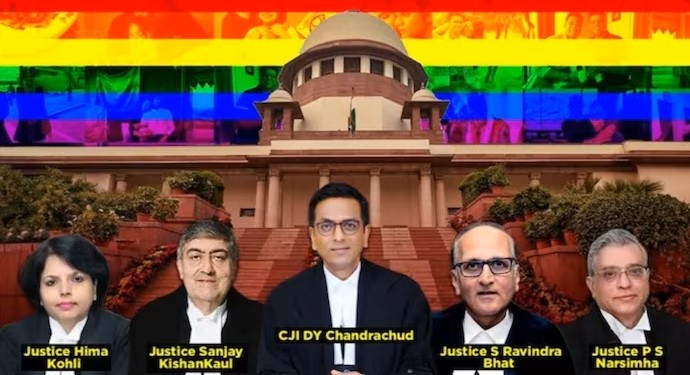In a landmark ruling, the Supreme Court of India has delivered its judgment on the issue of marriage equality, with a discerning 3:2 majority. This critical decision, while not conferring marriage recognition to non-heterosexual couples, significantly extends partial acknowledgment of their relationships by recognizing their right to be in a relationship.
In a thought-provoking minority judgment, the Chief Justice of India highlighted the imperative of viewing queerness as an inherent facet of human nature, rebuffing any notions of it being an urban elite concept or a manifestation of mental illness. Rather, he held that it is an intrinsic part of human diversity. Consequently, this perspective acknowledges the rights of non-heterosexual couples to establish legally recognized unions and the associated rights that emanate from such unions. Justice Chandrachud, concurring with the majority, underscored the evolving nature of the institution of marriage. He opined that, to recognize unions between non-heterosexual couples, legislative action is required.

Given that the petition in question challenged the Special Marriage Act 1955 and sought for a reading down of the Act, the Court held that it faced a binary choice: either to strike down the Act and revert to a pre-independence era where interfaith marriages were not recognized, or to interpret the existing law more inclusively. The latter path, however, the Court held would entail the risk of transgressing judicial boundaries, potentially disrupting the separation of powers and ultimately, the Court refrained from acting in that direction.
Justice Bhat, while contributing to the majority judgment, argued that marriage is fundamentally a social institution and, as such, cannot be firmly ingrained as a fundamental right under Article 21 of the Indian Constitution. Instead, it is a recognized statutory right in India. This perspective relinquishes the immediate pursuit of a comprehensive legal framework for the queer community, placing the responsibility upon the legislature to formulate appropriate laws regulating the complex plethora of rights arising from the union of queer couples. He acknowledged that queer couples have a right to form relationships, encompassing the freedom to choose a partner, cohabit, engage in physical intimacy, and safeguard their autonomy, privacy, and dignity. However, the judgment is conspicuously silent on the precise connotations of “cohabit,” leaving room for diverse interpretations. Notably, “cohabitation” denotes living together and engaging in a sexual relationship without formal marriage, potentially culminating in a “live-in relationship” after an extended period. It is paradoxical that, while the judgment champions the basic rights of queer couples, the legal recognition of “live-in relationships” too remains elusive for them. The concept of the “right to a relationship” can be seen as a progressive step toward deconstructing societal norms surrounding queer relationships, recognizing them socially, if not yet legally.
This judgment eloquently recognizes the loss of social security, welfare benefits, and various advantages that queer couples may forfeit due to their legal status. It places the onus squarely on the legislature to address these inequities and create a more inclusive legal framework for the queer community, thereby marking a significant turning point in the struggle for LGBTQIA+ rights in India and likewise shifting the burden on legislature. This judgment imposes a responsibility on the legislature to establish a committee tasked with examining the rights and benefits enjoyed by queer couples and addressing the discriminations they endure as a consequence of the lack of recognition of their unions.
Thus, queer couples now possess the fundamental right to enter a relationship that encompasses the freedom to cohabit and to fully embrace their mental and physical togetherness, while also safeguarding their protection against any coercive or involuntary dissolution of their relationship.

